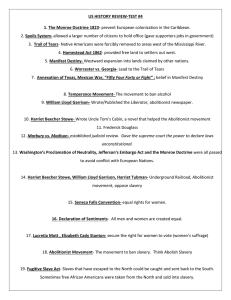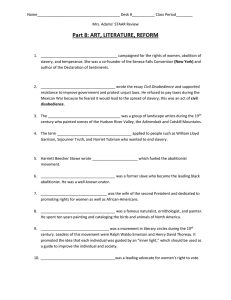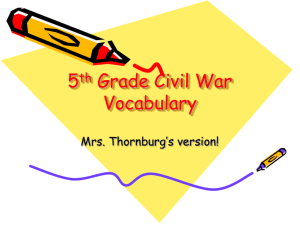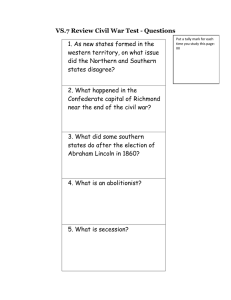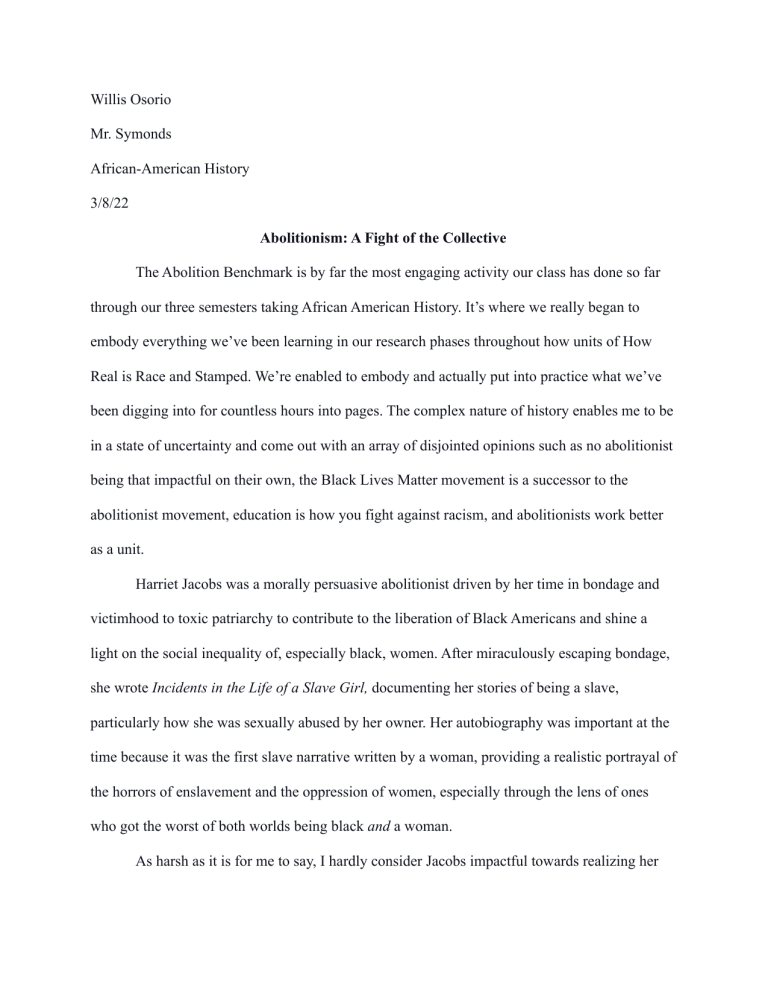
Willis Osorio Mr. Symonds African-American History 3/8/22 Abolitionism: A Fight of the Collective The Abolition Benchmark is by far the most engaging activity our class has done so far through our three semesters taking African American History. It’s where we really began to embody everything we’ve been learning in our research phases throughout how units of How Real is Race and Stamped. We’re enabled to embody and actually put into practice what we’ve been digging into for countless hours into pages. The complex nature of history enables me to be in a state of uncertainty and come out with an array of disjointed opinions such as no abolitionist being that impactful on their own, the Black Lives Matter movement is a successor to the abolitionist movement, education is how you fight against racism, and abolitionists work better as a unit. Harriet Jacobs was a morally persuasive abolitionist driven by her time in bondage and victimhood to toxic patriarchy to contribute to the liberation of Black Americans and shine a light on the social inequality of, especially black, women. After miraculously escaping bondage, she wrote Incidents in the Life of a Slave Girl, documenting her stories of being a slave, particularly how she was sexually abused by her owner. Her autobiography was important at the time because it was the first slave narrative written by a woman, providing a realistic portrayal of the horrors of enslavement and the oppression of women, especially through the lens of ones who got the worst of both worlds being black and a woman. As harsh as it is for me to say, I hardly consider Jacobs impactful towards realizing her dreams of emancipation and equality among genders. As a collective with other abolitionists across the United States, yes, she did play her part in shining light on the unspoken injustices stated before. The combined resolve of the abolitionist movement was embodied through Abraham Lincoln ending slavery in 1865 with his Emancipation Proclamation during the Civil War. In other words, I feel like Jacobs didn't play an important role in freeing slaves without working as a unit with every abolitionist because no abolitionist can Like a soldier in the army, no soldier single-handedly wins a war, just like one abolitionist didn’t single-handedly end slavery. Having the privilege to play the heroine myself throughout our class’ four faux AASS (American Anti-Slavery Society) meetings, I contributed with the notion that Harriet Jacobs walks the fine line between radical, immediate abolition, gradualism, “slowly but surely” emancipation. I say this because although she supported abolition through writing and the media as opposed to people like Harriet Tubman and John Brown who favor physical abolition (armed uprisings, conducting the underground railroad), she aligns with their sense of urgency considering how she defied all odds in the way she escaped slavery, risking her life. Putting myself in her shoes, I found myself debating for the minority most of the time. I was outvoted during the discussion on whether or not we would join the women’s rights movement in 1848, and the AASS vote on opposing the fugitive slave act with arms, which I believed she would say yes and no to respectively. To put it simply, I interpreted Harriet Jacobs as a slightly radical abolitionist in the sense that her beliefs are less common. I respect how Harriet Jacobs overcame all systemic odds against her skin pigmentation through sheer will (she hid in a cramped attic for 7 years!); despite this, I feel that she limited herself a lot in terms of abolitionist strategies. While I doubt she was a colonizationist, I observed she only focused on the small(er) byproducts of slavery—like saving southern Black refugees during the Civil War. From her accomplishments as an abolitionist, I would argue she didn't see the big picture for abolition that being a permanent establishment of black betterment, not just temporary help. The most important obstacle to the abolition movement from the opposition is America's flourishment from racism. A historical example of this is the burning of Pennsylvania Hall in 1838. After the Pennsylvania Anti-Slavery Society bought the building as a place for a convention, a group of citizens (usually white) enticed to racism through its economic benefits rioted against their word of abolition for slaves who threatened to steal job openings from whites with their freedom. Many were hurt and most of all Pennsylvania Hall was set on fire. From this historical event, it's made apparent how difficult and risky it was to combat slavery since no one cares about how wrong it is, but about the advantages it grants them. Aside from general adversity from the racist opposition, abolitionists faced internal struggle as they organized themselves into a group; for example, polarization in methods. Despite fighting for the same cause, they had very different methods in mind to reach emancipation. An example is our 1850 AASS discussion, which bore the question of whether to support armed attempts to stop the enforcement of the Fugitive Slave Act. While my classmate Nick, portraying abolitionist William Still, proposed we should defend ourselves, arguing we can’t just sit around waiting to get captured. I, reluctantly, argued in the eyes of Harriet Jacobs and said that how we were sure to lose the game of violence and risk worsening the root of slavery, racist ideas. I argued that even though unlikely victory, we will racist depictions of Black people being violent savages and the misconstruction of the abolitionist movement. While I personally believed nonviolence in this situation was wrong I’m unsure of what Harriet Jacobs would’ve actually sided with, but I went with Jacob’s deep belief in Christianity and therefore pacifism with my limited understanding of Christianity. Funnily classmate Aviva who was also assigned Jacobs went into the debates on the opposite side: for violence. However, after doing a bit of digging myself she might’ve made the right decision considering that in the Bible there is a statement on self-defense. In hindsight, she was more right. While I believe Harriet Jacobs would’ve been on board with the self-defense compromise, I don’t think it’s in her character to be on the more proactive side of violence. That is, actively organizing a militia to beat slaveowners and racists to the punch with armed attacks and uprisings. One way my perspective has changed as a result of these discussions was seeing no abolitionist method was right in their own way. I initially came into the discussion thinking that violence was the only way to stop considering what actually ended slavery, war. However, it was much more complicated than that. Violence could be boiled down to risk-for-reward where you had the positive of achieving emancipation faster, but with the potential consequence of a fiasco with the possibility of failure. For example, going violent as a tactic of opposing the Fugitive Slave Act could mean the preservation of free Northern Black people. However, educating and slowly and methodically building opposition to slavery—be it through propaganda, speeches, gatherings, etc.— while threatening to keep the problem for longer has the benefit of not worsening it like the failure of violent affairs would. After putting myself in the shoes of an abolitionist in the 1800s, both strategies made complete sense. While the abolitionist and Black Lives Matter movements share the general goal of better black livelihood in the US, I can’t help but spot more of their differences. Within their 200 year gap, the abolitionist movement focused on slavery when the Black Lives Matter movement was centered around the social and economic disparity Black people face. For example, according to Trevor Noah's interview with Patrisse Cullors in The Daily Social Distancing Show, Cullors states, "The BREATHE Act [...] is looking at how do we not just talk about divesting or defunding from the police what does it look like to reinvest into our communities." They're essentially saying explaining how BLM's goal is not only to reduce funds for the police, a means to stop "over-policing," and use those funds to support people who are struggling to live under the current distribution of taxpayer dollars. Both groups have had some form of violent uprising in their name. Violence in the abolition movement was in the form of organized militias as opposed to BLM’s fiery riots conducted by everyday citizens whether from actual protestors or saboteurs. While The most important difference between the two strides for equality is how the public perceived them. During the 1800s, abolitionism was a radical idea especially since racism was lucrative. Slavery bolstered the American economy thanks to the high demand for cotton and the US’ willingness to supply it. As a result, there was no incentive not to be racist. On the contrary, modern society has reached a general intolerance for racism. What I mean by that is most people nowadays aren’t racist or at least don’t project racism, at least not to the degree racist ideas were openly expressed during America’s infancy. However, despite all of these differences, both movements are strongly intertwined. The Black Lives Matter movement is a direct descendant of the path the abolitionist movement has paved for Black Betterment. After being educated on the abolitionist movement, I understand that current movements for racial justice in the US are picking up the breadcrumbs from the real issue that was slavery (comparatively). That’s not to say social inequality isn’t a horrible thing, however, it wasn’t nearly as bad someone torturing another person, to force them to perform labor with no compensation, due to the justification that they were inferior. If there's anything I took away it's that thanks to people like William Lloyd Garrison, Frederick Douglass, and Harriet Jacobs, the impending wall of enslavement was taken down, opening the doors to improving black lives. This is where activists such as Malcolm X and Martin Luther push forward with the Civil Rights Movement taking out large aspects of racial injustice being such as legal segregation. We're finally left in the present where Alicia Garza, Patrisse Cullors, and Opal Tometile are hammering down the final nails of social and economic inequality that stick out with their Black Lives Matter Movement. The role of the individual in the fight for an anti-racist future is to educate themselves. As stated by the author of Stamped, Ibram X. Kendi, education reinforces a fair understanding of the past, and therefore the present and the future. The educated individuals will be the ones capable of holding fruitful conversations as over time they strengthen and unite to become the educated collective. The educated collective will be the ones to steer us towards an anti-racist future with. Notes: AASS Choices: 1833: Will the American anti-Slavery Society contribute funds for colonization and allow its name to be used in this effort? ● Historical Context: ○ Slave Trade Act (1807) ■ Stop importing people from Africa and Caribbean ■ Illegal slave traders fined ■ Did nothing to stop domestic slavery and the international slave trade ○ Missouri Compromise of 1820 ■ Views on abolitionism and racism divided ○ William Lloyd Garrison started The Liberator ■ A big source of abolitionist propaganda ○ Nat Turner’s rebellion (1831) ■ Tighter racist leash ○ AASS founding (1833) ■ Abolitionism is becoming a larger institution ● Arguments: ○ Pro: Yes, colonization ■ Need end slavery one at a time ● By one slave freedom at a time ■ Not gonna end slavery as an institution, but gonna end it permanently for the freed ■ Free blacks can return to Africa ● Cuz of Noth and South racism, it’s good to have their own homeland in Africa ○ American prejudice so deep blacks will never live free in the US ○ Anti: No, colonization ■ AASS needs to end slavery for GOOD, not just buy a couple of people’s freedom ■ Even if bought out lots of people, the price of enslaved people would increase ● Supply and demand ■ Most slaves were born in America at this point ● So they deserve freedom in the land they’ve worked so hard to build ○ If there’s discrimination then we go stop it 1848: Should the AASS publicly endorse the women’s Seneca Falls Convention? ● Historical Context: ○ Firsthand slave narrative (1845): Narrative of the Life of Frederick Douglass, an American Slave ■ The horror of slavery brought to light ● Arguments: ○ Pro: Abolition movement should stand against all oppression ■ Women abolitionists were more effective if allowed to speak publicly ■ Woman’s movement would bring in more people ■ We’re trying to build a society on equality and freedom from all oppression anyways ○ Anti: No, this is nonsense ■ Could divide anti-slavery forces ● Weakens the anti-slavery movement ■ Slavery is worse 1850: Should AASS support armed attempts to stop enforcement of the Fugitive Slave Act? ● Historical Context: ○ Mobet’s suing her way to freedom(1781) ■ Religious suasion ● Use religion to guilt slave owners to free slaves ○ America ran on slavery ■ Cotton monopoly ● Eli Whitney’s Cotton Gin (1794) ○ Free and enslaved people are scared cuz they can just get taken ○ Freedom does not equality ■ Freedom kinda crap ● Still racism ○ Scientific Pro-slavery ■ “Proof” blacks less int ○ North = South’s police ○ Bounty hunters and law enforcement running everywhere ○ Risky escape attempts ■ Underground railroad to the north ■ Go to Canada ● Arguments: ○ Pro: AASS become militant ■ Non-violence doesn’t work ● Law and gov on slaveowners’ side, who are more willing to use violence ○ Slaveowners better armed ○ Anti: No violence ■ Risk turning people away ● More people than every think slavery is evil ■ Educate against slavery instead ● Writing ● Speaking out ● Building opposition to slavery ■ Using violence would be playing into the hands of the government and slave owners ● They are sure to win the game of violence 1858: Should AASS support John Brown’s violent anti-slavery uprisings with money and/or guns? If not, alternatives? ● Historical Context: ○ Uncle Tom’s Cabin (1852) ■ “Blacks are better Chistrians than Whites” ■ Drew many northerners to the abolitionist movement ○ Supreme Court ruled in Dred Scott case that Western US territories cannot prohibit slavery ■ Chief Justice Roger Taney wrote for court majority: no black person in the United States had “any rights which the white man is bound to respect.” ■ More slaves than ever in US ● >4mil ■ More arguement for action: ● John Brown ○ Led fight to have Kansas admitted to US as free state. ○ Raising money ■ Asking AASS for resources ● Arguments: ○ Pro: Yes, Brown ■ Some say: Just don’t give him money, no guns, so if he fails we don’t take the fall too ■ Nonviolent for 30 years yet slavery is more entrenched than before ● Old tactics not working ● You can win public opinion, but no end to slavery ■ Slavery must end by force ● Brown’s time in Kanas makes him capable of doing so ● Good Southern raids can encourage slaves to escape and slave uprisings ○ Anti: No, Brown ■ The small army would get bopped by the US ■ If gov discovered links between Brown and AASS then org can get attacked or outlawed ■ We don’t really know what will end slavery, but this definitely won’t ○ Verdict: IDK so the group disbanded Differences: ● Time period ○ 1800s vs 2000s ● Violence through regular unarmed citizens in BLM vs. violent uprising through organized militias ● Slavery focused vs. racism focused ○ They use media for different goals (somewhat) ○ Abolitionism uses writing, speeches, and education to build opposition to slavery ○ BLM uses media and speeches to redistribute taxpayer dollars ■ Divest police and reinvest in communities ● Abolitionism was more radical at the time vs BLM ○ As a result of the abolitionist movement and further flights for racial justice, the ideas behind BLM are the majority vs abolitionism trying to end America’s golden boy for money, slavery. Patrisse Cullors Interview:
